Ch.10
0.0(0)
Card Sorting
1/84
Study Analytics
Name | Mastery | Learn | Test | Matching | Spaced |
|---|
No study sessions yet.
85 Terms
1
New cards
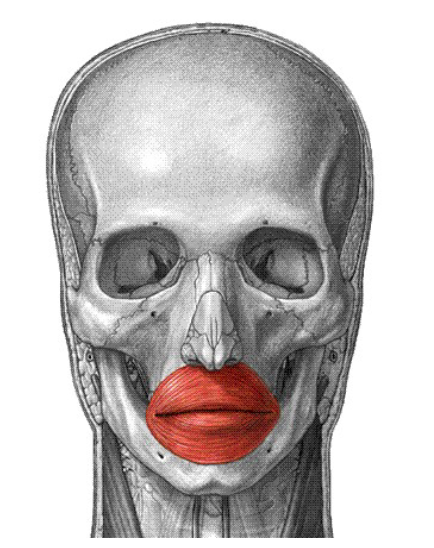
Origin: Maxilla and mandible
Insertion: into muscle and skin at angles of mouth
Action: closes lips
Insertion: into muscle and skin at angles of mouth
Action: closes lips
Orbicularis Oris
2
New cards
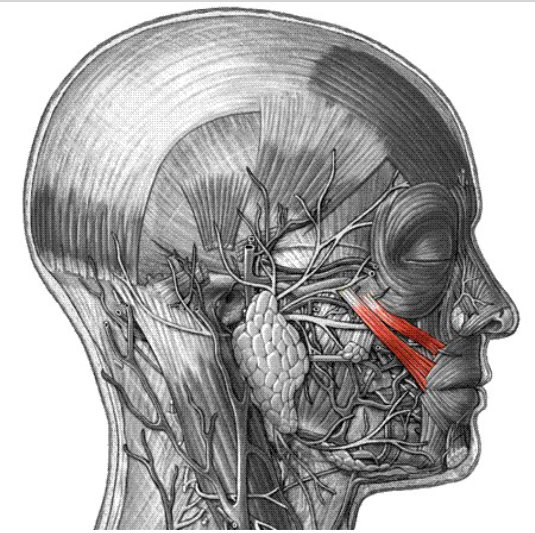
Origin: zygomatic bone
Insertion: skin and muscle at corner of mouth
Action: raises corners of mouth
Insertion: skin and muscle at corner of mouth
Action: raises corners of mouth
Zygomaticus
3
New cards
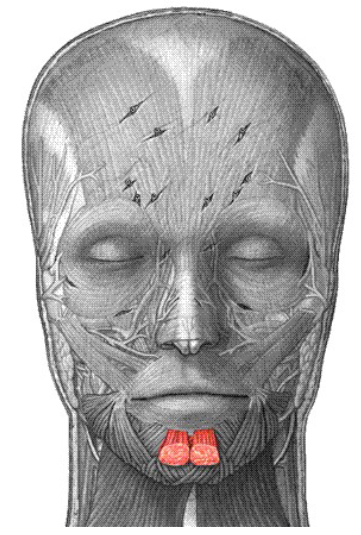
Origin: mandible below incisors
Insertion: Skin of chin
Action: wrinkles chin, protrudes lower lip (as in a pout)
Insertion: Skin of chin
Action: wrinkles chin, protrudes lower lip (as in a pout)
Mentalis
4
New cards
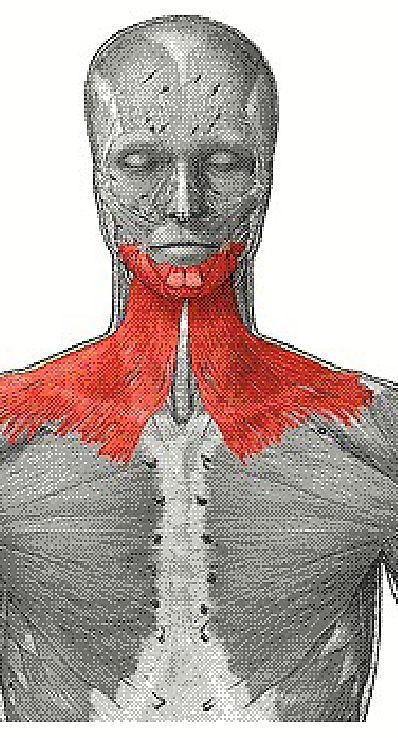
Origin: fascia of chest
Insertion: lower margin of mandible
Action: Tenses skin of neck, pulls lower lip back and down (downward sag of mouth)
Insertion: lower margin of mandible
Action: Tenses skin of neck, pulls lower lip back and down (downward sag of mouth)
Platysma
5
New cards
origin: arch of frontal bone above nasal bone
insertion: skin of eyebrow
action: pulls eyebrows medially and inferiorly, wrinkles skin of forhead
insertion: skin of eyebrow
action: pulls eyebrows medially and inferiorly, wrinkles skin of forhead
Corrugator supercilii
6
New cards
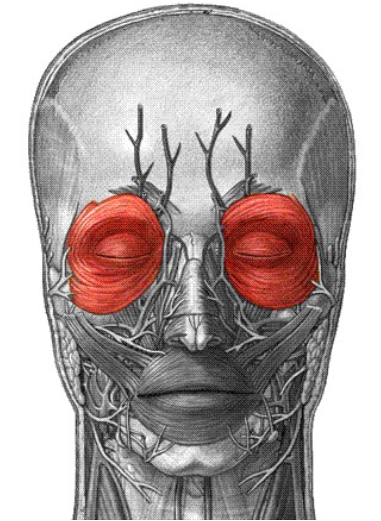
Origin: Frontal and maxillary bones
Insertion: Tissue of eyelids
Action: Closes eye, pulls eyebrow inferiorly
Insertion: Tissue of eyelids
Action: Closes eye, pulls eyebrow inferiorly
Orbicularis Oculi
7
New cards
Two part muscle consisting of the frontal and occipital bellies connected by epicranial aponeurosis. The alternate actions pulls scalp forward and backward
Epicranius (Occipitofrontalis)
8
New cards
Origin: epicranial aponeurosis
Insertion: skin of eyebrows and root of nose
Action: raises eyebrows and wrinkles forhead skin horizontally
Insertion: skin of eyebrows and root of nose
Action: raises eyebrows and wrinkles forhead skin horizontally
Frontal belly
9
New cards
Origin: occipital bone and temporal bones
Insertion: epicranial aponeurosis
Action: Pulls scalp posteriorly
Insertion: epicranial aponeurosis
Action: Pulls scalp posteriorly
Occipital Belly
10
New cards
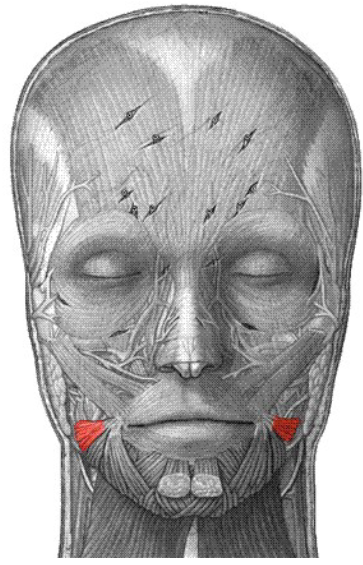
Origin: fascia associated with masseter muscle
Insertion: skin at angle of mouth
Action: pulls corner of lip laterally, tenses lip; synergist of zygomatic
Insertion: skin at angle of mouth
Action: pulls corner of lip laterally, tenses lip; synergist of zygomatic
Risorius
11
New cards
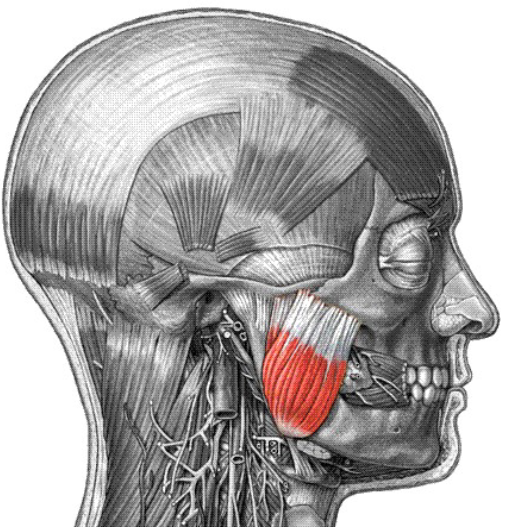
Origin: Zygomatic arch and bone
Insertion: angle and ramus of mandible
Action: Prime mover of jaw; closure
Insertion: angle and ramus of mandible
Action: Prime mover of jaw; closure
Masseter (1/3 chewing muscles)
12
New cards
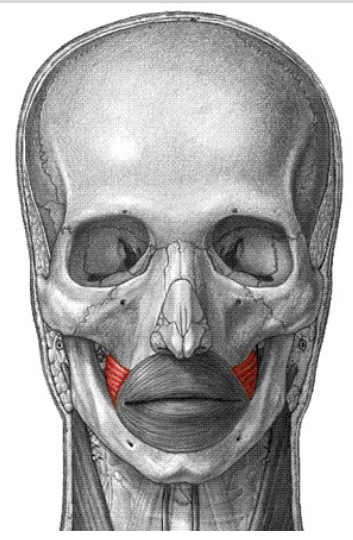
Origin: Molar region of maxilla and mandible
Insertion: corner of the mouth (orbicularis oris)
Action: compress cheeks
Insertion: corner of the mouth (orbicularis oris)
Action: compress cheeks
Buccinator
13
New cards
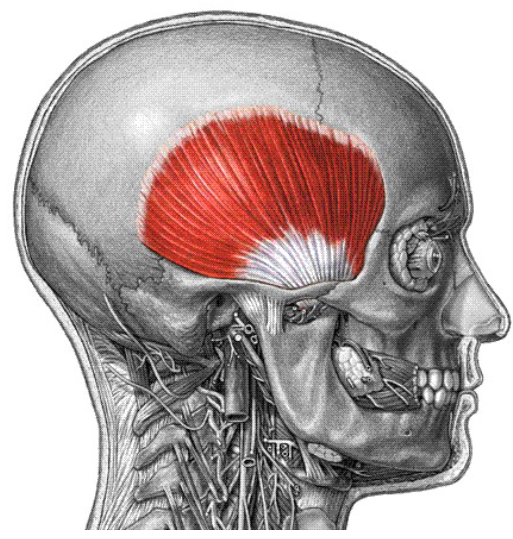
Origin: temporal fossa
Insertion: coronoid process of mandible
action: closes jaw
Insertion: coronoid process of mandible
action: closes jaw
Temporalis (1/3 chewing muscles)
14
New cards
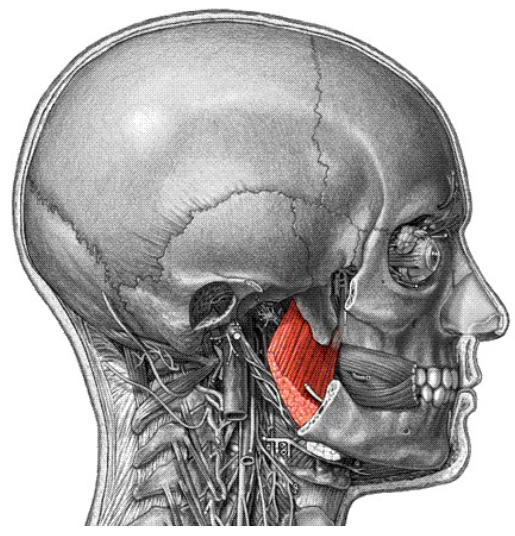
Origin: Pterygoid plate of sphenoid bone
Insertion: Medial surface of mandible near the angle
Action: Acts with the lateral pterygoid muscle to protract (pull anteriorly) the mandible and promote side-to-side grinding movement
Insertion: Medial surface of mandible near the angle
Action: Acts with the lateral pterygoid muscle to protract (pull anteriorly) the mandible and promote side-to-side grinding movement
Medial Pterygoid (1/3 chewing muscles)
15
New cards
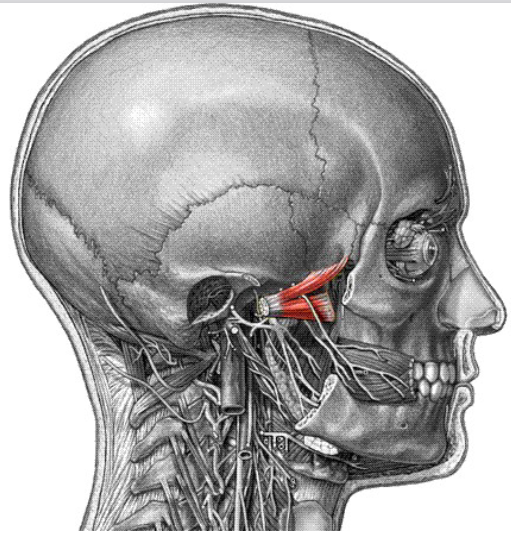
Origin: greater wing and lateral pterygoid plate of sphenoid bone
Insertion: Condylar process of mandible
Action: Provides side-to-side grinding movements
Insertion: Condylar process of mandible
Action: Provides side-to-side grinding movements
Lateral Pterygoid (1/3 chewing muscles)
16
New cards
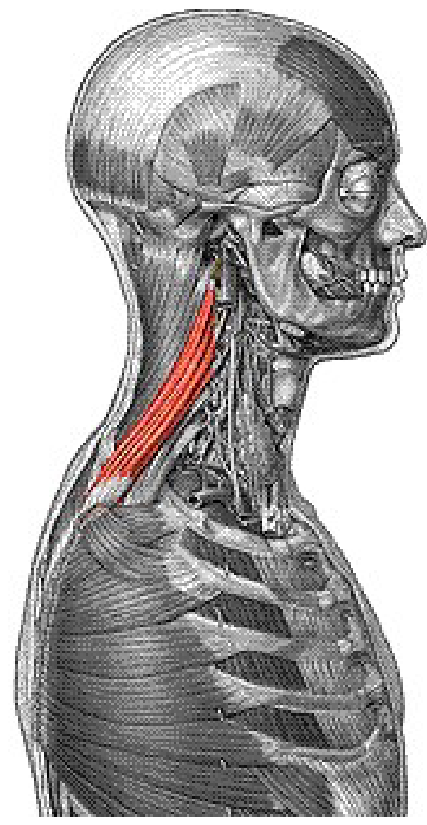
Origin: transverse process of C1-C4
Insertion: Medial border of scapula, superior to spine
Action: elevates and adducts scapula
Insertion: Medial border of scapula, superior to spine
Action: elevates and adducts scapula
Levator Scapulae
17
New cards
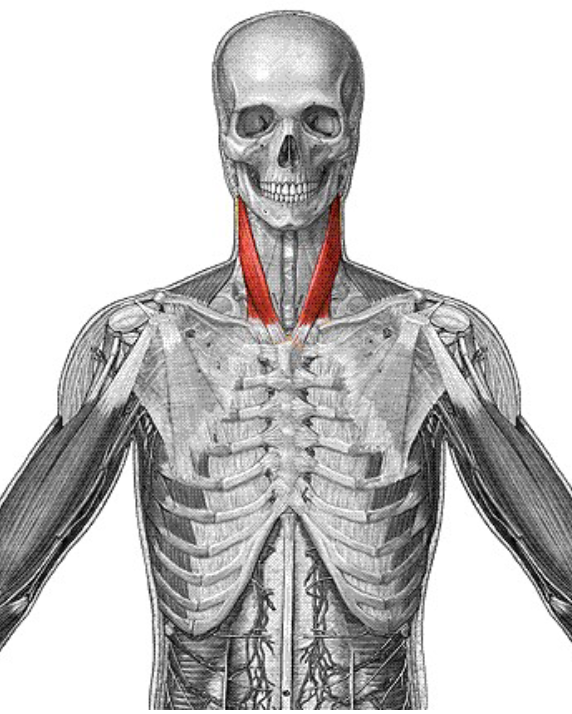
Origin: Manubrium of sternum
Insertion: mastoid process of temporal bone
Action: Flexes and laterally rotates the head
Insertion: mastoid process of temporal bone
Action: Flexes and laterally rotates the head
Sternocleidomastoid
18
New cards
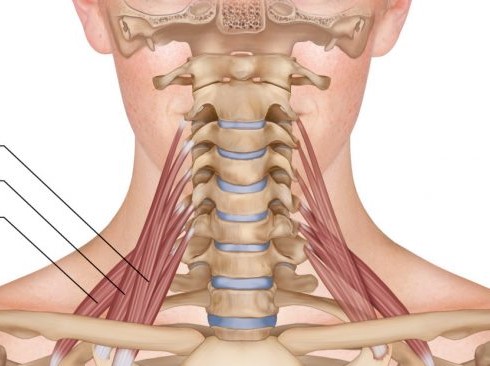
Origin: transverse processes of cervical vertebrae
Insertion: anterolaterally on first two ribs
Action: Elevate first two ribs
Insertion: anterolaterally on first two ribs
Action: Elevate first two ribs
Scalenes
19
New cards
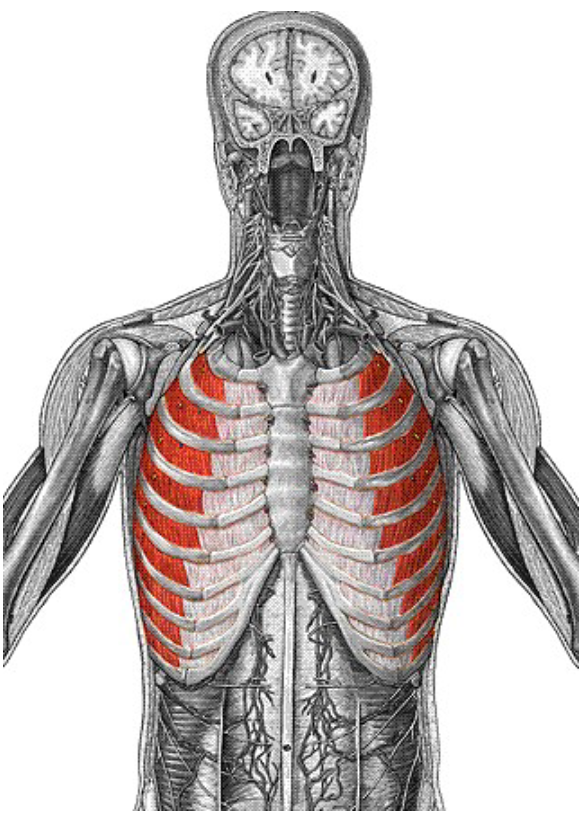
Origin: inferior border of rib above
Insertion: superior border of rib below
Action: Pull ribs toward one another to elevate rib cage
Insertion: superior border of rib below
Action: Pull ribs toward one another to elevate rib cage
external intercostals
20
New cards
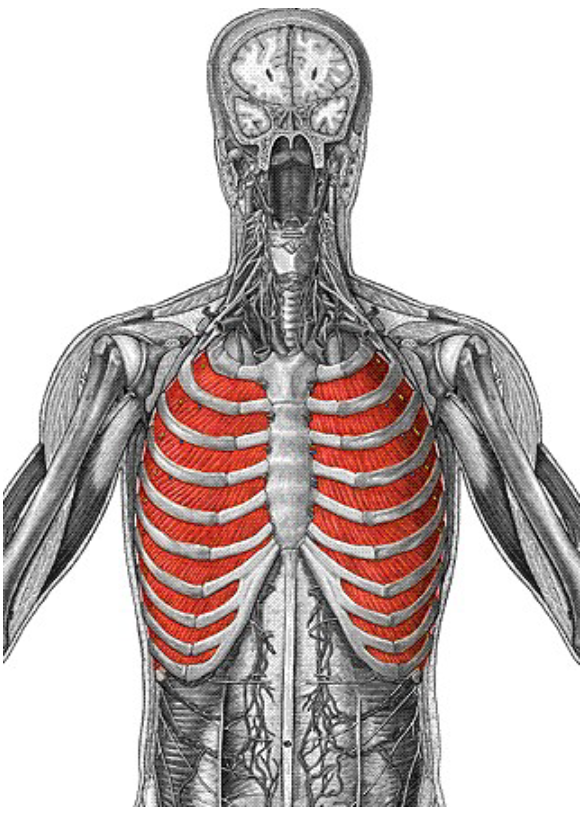
Origin: Superior border of rib below
Insertion: Inferior border of rib above
Action: Pull ribs together and depress rib
Insertion: Inferior border of rib above
Action: Pull ribs together and depress rib
internal intercostals
21
New cards
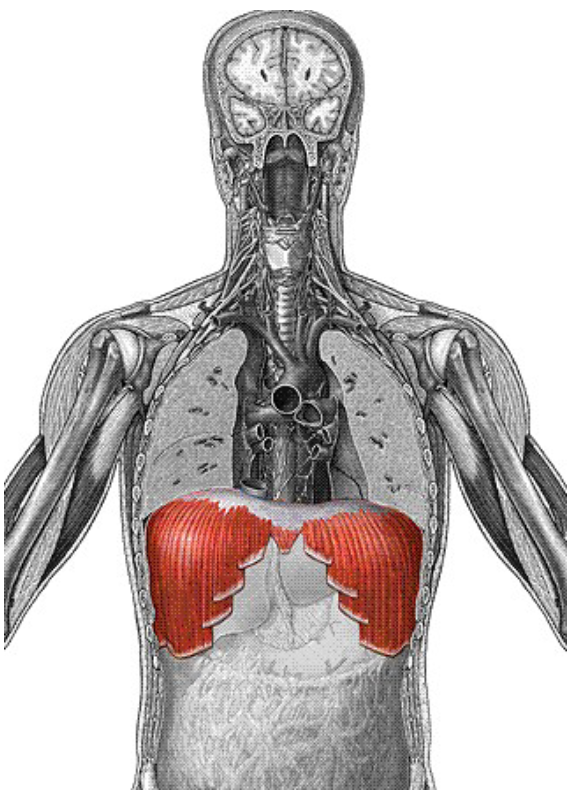
Origin: Inferior, internal surface of rib cage and sternum, costal cartilages
Insertion: Central tendon
Action: Prime mover of inspiration; flattens on contraction
Insertion: Central tendon
Action: Prime mover of inspiration; flattens on contraction
Diaphragm
22
New cards
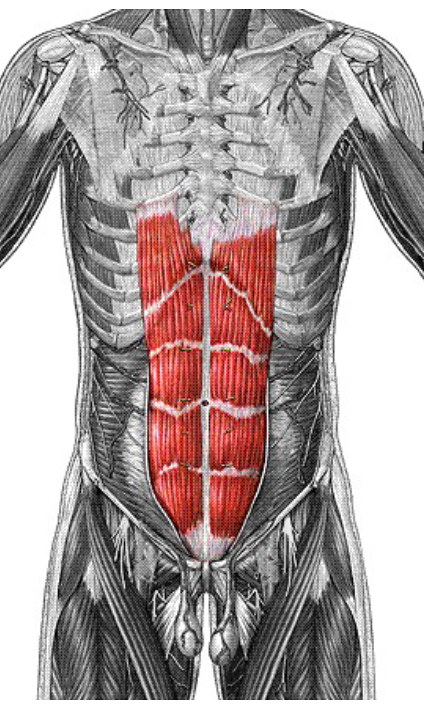
Origin: pubic crest and symphysis
Insertion: xiphoid process and costal cartilages of ribs 5-7
Action: flexes and rotates lumbar region of vertebral column
Insertion: xiphoid process and costal cartilages of ribs 5-7
Action: flexes and rotates lumbar region of vertebral column
Rectus Abdominis
23
New cards
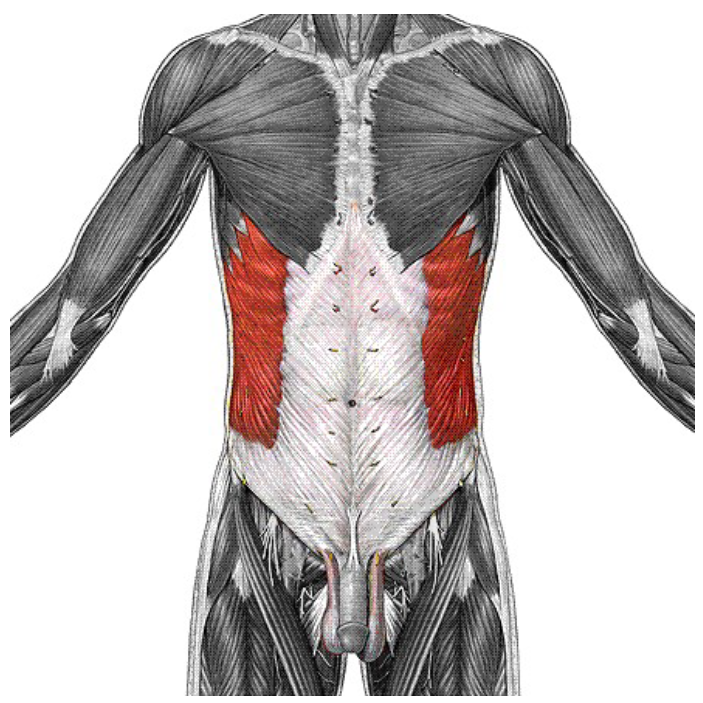
Origin: fleshy strips from outer surfaces of lower eight ribs
Insertion: fibers insert into linea alba via a broad aponeurosis; some insert into pubic crest
Action: flex vertebral column and compress abdominal wall and trunk rotation and lateral flexion
Insertion: fibers insert into linea alba via a broad aponeurosis; some insert into pubic crest
Action: flex vertebral column and compress abdominal wall and trunk rotation and lateral flexion
External Oblique
24
New cards
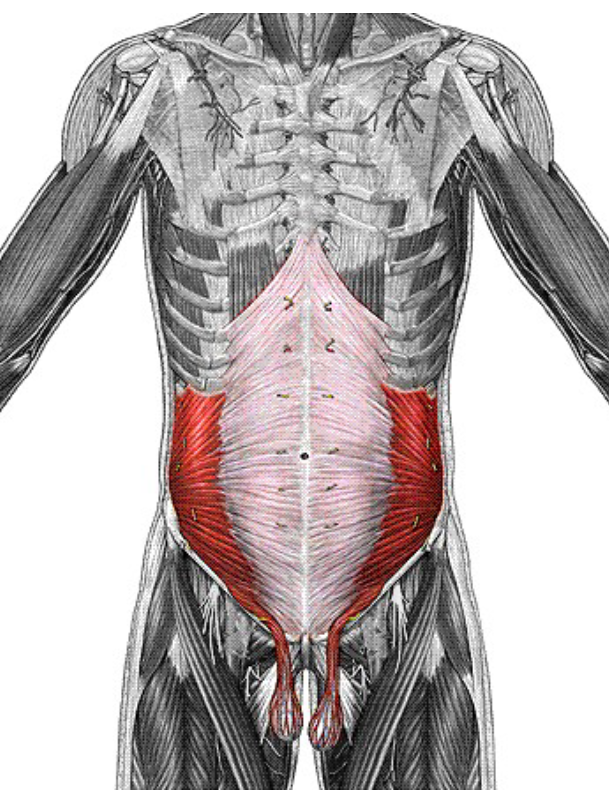
Origin: lumbar fascia, iliac crest, inguinal ligament
Insertion: linea alba
Action: as for external oblique
Insertion: linea alba
Action: as for external oblique
Internal Oblique
25
New cards
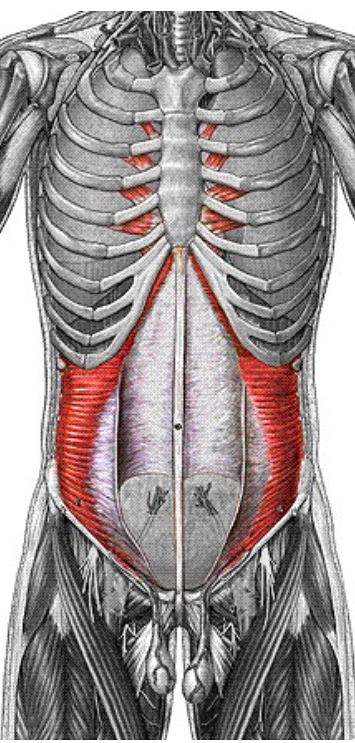
Origin: inguinal ligament, lumbar fascia
Insertion: linea alba, pubic crest
Action: compresses abdominal contents
Insertion: linea alba, pubic crest
Action: compresses abdominal contents
Transversus Abdominis
26
New cards
Origin: ribs 3-5
insertion: coracoid process of scapula
Action: with ribs fixed, pulls scapula forward and downward
insertion: coracoid process of scapula
Action: with ribs fixed, pulls scapula forward and downward
Pectoralis Minor
27
New cards
origin: ribs 1-8
insertion: entire anterior surface of medial border of scapula
Action: Rotates scapula so its inferior angle moves laterally and upward
insertion: entire anterior surface of medial border of scapula
Action: Rotates scapula so its inferior angle moves laterally and upward
Serratus Anterior
28
New cards
Origin: ligamentum nuchae
Insertion: continuous insertion along acromion and spin of scapula
Action: Retracts, and rotates scapula
Insertion: continuous insertion along acromion and spin of scapula
Action: Retracts, and rotates scapula
Trapezius
29
New cards
Origin: spinous processes of C7-T1 (minor), spinous processes of T2-T5 (major)
Insertion: medial border of scapula
Action: stabilize scapula
Insertion: medial border of scapula
Action: stabilize scapula
Rhomboid Major and Minor
30
New cards
Origin: Sternal End of Clavicle
Insertion: Fibers converge to insert by a short tendon
Action: Adducts medially rotates arm
Insertion: Fibers converge to insert by a short tendon
Action: Adducts medially rotates arm
pectoralis major
31
New cards
Origin: Lateral third of clavicle
Insertion: Deltoid tuberosity of humerus
Action: Prime mover of the arm when all its fibers contract simultaneously
Insertion: Deltoid tuberosity of humerus
Action: Prime mover of the arm when all its fibers contract simultaneously
Deltoid
32
New cards
Origin: indirect attachment via lumbodorsal fascia into spines
Insertion: Spirals around teres major
Action: Prime mover of arm extention; powerful arm addcutor; medially rotates arm
Insertion: Spirals around teres major
Action: Prime mover of arm extention; powerful arm addcutor; medially rotates arm
Latissimus Dorsi
33
New cards
Origin: subscapular fossa
Insertion: lesser tubercle of humerus
Action: Rotates arm medially
Insertion: lesser tubercle of humerus
Action: Rotates arm medially
Subscapularis
34
New cards
Origin: supraspinous fossa of scpula
Insertion: superior part of greater tubercle of humerus
Action: Intiates abduction of arm
Insertion: superior part of greater tubercle of humerus
Action: Intiates abduction of arm
Supraspinatus
35
New cards
Origin: Infraspinous fossa of scapula
Insertion: Greater tubercle of humerus posterior to insertion
Action: Rotates arm laterally
Insertion: Greater tubercle of humerus posterior to insertion
Action: Rotates arm laterally
Infraspinatus
36
New cards
Origin: Lateral border of dorsal scapular surface
Insertion: Greater tubercle of humerus inferior to infraspinatus insertion
Action: Same as infraspinatus
Insertion: Greater tubercle of humerus inferior to infraspinatus insertion
Action: Same as infraspinatus
Teres Minor
37
New cards
Origin: Posterior surface of scapula
Insertion: Crest of lesser tubercle
Action: Extends, medially rotates, and adducts arm
Insertion: Crest of lesser tubercle
Action: Extends, medially rotates, and adducts arm
Teres Major
38
New cards
Origin: coracoid process of scapula
Insertion: medial surface of humerus shaft
Action: Flexes and adducts arm
Insertion: medial surface of humerus shaft
Action: Flexes and adducts arm
Coracobrachialis
39
New cards
Origin: Long head infraglenoid tubercle
Insertion: common tendon into olecranon on ulna
Action: Powerful forearm extensor
Insertion: common tendon into olecranon on ulna
Action: Powerful forearm extensor
Triceps Brachii
40
New cards
Origin: Short head: coracoid
Insertion: common tendon into radial tuberosity
Action: Flexes and supinates forearm
Insertion: common tendon into radial tuberosity
Action: Flexes and supinates forearm
Biceps Brachii
41
New cards
Origin: Anterior side of humerus
Insertion: Tuberosity and coronoid process
Action: Flexes forearm
Insertion: Tuberosity and coronoid process
Action: Flexes forearm
Brachialis
42
New cards
Origin: Lateral supracondylar ridge at distal end of humerus
Insertion: Base of radial styloid process
Action: Synergist in flexing forearm
Insertion: Base of radial styloid process
Action: Synergist in flexing forearm
Brachioradialis
43
New cards
Origin: Medial epicondyle
Insertion: common tendon into lateral radius
Action: Pronates forearm
Insertion: common tendon into lateral radius
Action: Pronates forearm
pronator teres
44
New cards
Origin: Medial epicondyle of humerus
Insertion: Base of second and third metacarpals
Action: Powerful Flexor of hand
Insertion: Base of second and third metacarpals
Action: Powerful Flexor of hand
flexor carpi radialis
45
New cards
Origin: Medial epicondyle
Insertion: Fascia of palm
Action: Tenses skin and fascia of palm during movements
Insertion: Fascia of palm
Action: Tenses skin and fascia of palm during movements
Palmaris Longus
46
New cards
Origin: Medial epicondyle of humerus
Insertion: Pisiform and hamate bones
Action: Powerful flexor and adductor of hand
Insertion: Pisiform and hamate bones
Action: Powerful flexor and adductor of hand
Flexor Carpi Ulnaris
47
New cards
Origin: Medial epicondyle of humerus
Insertion: four tendons into middle phalanges
Action: Flexes hand and middle phalanges of second to fifth fingers
Insertion: four tendons into middle phalanges
Action: Flexes hand and middle phalanges of second to fifth fingers
flexor digitorum superficialis
48
New cards
Origin: coronoid process
Insertion: four tendons into distal phalanges
Action: Flexes distal interphalangeal joints
Insertion: four tendons into distal phalanges
Action: Flexes distal interphalangeal joints
flexor digitorum profundus
49
New cards
Origin: lateral supracondylar ridge of humerus
Insertion: Base of second metacarpal
Action: Extends hand and abducts hand
Insertion: Base of second metacarpal
Action: Extends hand and abducts hand
Extensor Carpi Radialis Lonhgus
50
New cards
Origin: Lateral epicondyle of humerus
Insertion: Base of third metacarpal
Action: Extends and abducts hand
Insertion: Base of third metacarpal
Action: Extends and abducts hand
Extensor Carpi Radialis Brevis
51
New cards
Origin: Lateral epicondyle of humerus
Insertion: Four tendons into extensor expansions
Action: Prime mover of finger extention
Insertion: Four tendons into extensor expansions
Action: Prime mover of finger extention
Extensor Digitorum
52
New cards
Origin: Lateral epicondyle of humerus
Insertion: Base of fifth metacarpal
Action: Extends hand, abducts hand
Insertion: Base of fifth metacarpal
Action: Extends hand, abducts hand
Extensor Carpi Ulnaris
53
New cards
Origin: Lateral epicondyle of humerus
Insertion: Proximal end of radius
Action: assists biceps brachii to forcibly supinate forearm
Insertion: Proximal end of radius
Action: assists biceps brachii to forcibly supinate forearm
Supinator
54
New cards
Origin: posterior surface of radius and ulna
Insertion: Base of first metacarpal and trapezium
Action: Abducts and extends thumb
Insertion: Base of first metacarpal and trapezium
Action: Abducts and extends thumb
Abductor Pollicis Longus
55
New cards
Origin: Dorsal shaft of radius
Insertion: Base of proximal and distal phalanx of thumb
Action: Extends thumb
Insertion: Base of proximal and distal phalanx of thumb
Action: Extends thumb
extensor pollicis brevis and longus
56
New cards
made up of the iliacus and psoas major
Illiopsoas
57
New cards
Origin: iliac fossa
Insertion: Lesser trochanter of femur
Action: Prime mover for flexing thigh
Insertion: Lesser trochanter of femur
Action: Prime mover for flexing thigh
Iliacus
58
New cards
Origin: Fleshy slips from transverse process
Insertion: Lesser trochanter of femur
Action: prime mover of thigh and flexes vertebral column laterally
Insertion: Lesser trochanter of femur
Action: prime mover of thigh and flexes vertebral column laterally
Psoas Major
59
New cards
Origin: Anterior superior iliac spine
Insertion: medial proximal tibia
Action: Flexes, abducts and laterally rotates thigh
Insertion: medial proximal tibia
Action: Flexes, abducts and laterally rotates thigh
Sartorius
60
New cards
Origin: pubis
Insertion: lesser trochanter inferior to linea aspera
Action: Adducts, flexes and medially rotates thigh
Insertion: lesser trochanter inferior to linea aspera
Action: Adducts, flexes and medially rotates thigh
Pectineus
61
New cards
Origin: Pubis near pubic symphysis
Insertion: linea aspera
Action: Adducts, flexes and medially rotates thigh
Insertion: linea aspera
Action: Adducts, flexes and medially rotates thigh
adductor longus
62
New cards
Origin: ischial and pubic rami
Insertion: linea aspera and adductor
Action: adducts and medially rotates and flexes thigh
Insertion: linea aspera and adductor
Action: adducts and medially rotates and flexes thigh
Adductor Magnus
63
New cards
Origin: inferior ramus and body of pubis
Insertion: medial surface of tibia
Action: adducts thigh, flexes and medially rotates leg
Insertion: medial surface of tibia
Action: adducts thigh, flexes and medially rotates leg
Gracillis
64
New cards
Origin: anterior inferior iliac spine and acetabulum
Insertion: patella and tibial tuberosity
Action: Extends leg and flexes thigh at hip
Insertion: patella and tibial tuberosity
Action: Extends leg and flexes thigh at hip
Rectus Femoris
65
New cards
Origin: Greater Trochanter, intertrochanteric line, gluteal tuberosity, linea aspera
Insertion: Patella, Tibial tuberosity, lateral+medial condyles
Action: Extends leg and stabilizes knee
Insertion: Patella, Tibial tuberosity, lateral+medial condyles
Action: Extends leg and stabilizes knee
Vastus Lateralis
66
New cards
Origin: Intertrochanteric line, linea aspera, medial supracondylar line
Insertion: Patella, Tibial tuberosity, lateral+medial condyles
Action: Extends legs
Insertion: Patella, Tibial tuberosity, lateral+medial condyles
Action: Extends legs
Vastus medialis
67
New cards
Origin: Anterior and lateral surfaces of femur
Insertion: Patella, Tibial tuberosity, lateral+medial condyles
Action: Extends leg
Insertion: Patella, Tibial tuberosity, lateral+medial condyles
Action: Extends leg
vastus intermedius
68
New cards
Origin: Anterior aspect of iliac crest
Insertion: iliotibial tract
Action: Steadies the leg and trunk on thigh by tightening iliotibial tract
Insertion: iliotibial tract
Action: Steadies the leg and trunk on thigh by tightening iliotibial tract
Tensor Fascia Lata
69
New cards
Origin: Dorsal ilium, sacrum and coccyx
Insertion: gluteal tuberosity
Action: Major extensor of thigh
Insertion: gluteal tuberosity
Action: Major extensor of thigh
Gluteus Maximus
70
New cards
Origin: Between anterior and posterior gluteal lines
Insertion: Short tendon into lateral aspect
Action: Abducts and medially rotates thigh
Insertion: Short tendon into lateral aspect
Action: Abducts and medially rotates thigh
Gluteus Medius
71
New cards
Origin: Anterolateral surface
Insertion: superior border of greater trochanter
Action: Rotates extended thigh laterally
Insertion: superior border of greater trochanter
Action: Rotates extended thigh laterally
Piriformis
72
New cards
Origin: Ischial tuberosity
Insertion: head of fibula and lateral condyle of tibia
Action: Extends thigh and flexes leg
Insertion: head of fibula and lateral condyle of tibia
Action: Extends thigh and flexes leg
Biceps femoris
73
New cards
Origin: Ischial tuberosity
Insertion: Medial aspect of upper tibial shaft
Action: Extends thigh and flexes leg
Insertion: Medial aspect of upper tibial shaft
Action: Extends thigh and flexes leg
Semitendinosus
74
New cards
Origin: ischial tuberosity
Insertion: Medial condyle of tibia
Action: Extends thigh and flexes leg
Insertion: Medial condyle of tibia
Action: Extends thigh and flexes leg
Semimembranosus
75
New cards
Origin: Lateral condyle
Insertion: medial cuneiform and first metatarsal
Action: Prime mover of dorsiflexion
Insertion: medial cuneiform and first metatarsal
Action: Prime mover of dorsiflexion
tibialis anterior
76
New cards
Origin: Lateral condyle of tibia
Insertion: Middle and distal phalanges
Action: Prime mover of toe extension
Insertion: Middle and distal phalanges
Action: Prime mover of toe extension
extensor digitorum longus
77
New cards
Origin: Anteromedial fibula
Insertion: distal phalanx of great toe
Action: Extends great toe
Insertion: distal phalanx of great toe
Action: Extends great toe
Extensor Hallucis Longus
78
New cards
Origin: head and upper portion
Insertion: first metatarsal and medial cuneiform
Action: plantar flexes and everts foot
Insertion: first metatarsal and medial cuneiform
Action: plantar flexes and everts foot
Fibularis longus
79
New cards
Origin: Distal fibula shaft
Insertion: lateral malleolus
Action: Plantar flexes everts foot
Insertion: lateral malleolus
Action: Plantar flexes everts foot
fibularis brevis
80
New cards
Origin: medial and lateral condyles of femur
Insertion: Posterior clacaneus
Action: plantar flexes foot
Insertion: Posterior clacaneus
Action: plantar flexes foot
Gastrocnemius
81
New cards
Origin: Extensive origin from superior tibia
Insertion: gastrocnemius
Action: plantar flexes foot
Insertion: gastrocnemius
Action: plantar flexes foot
Soleus
82
New cards
Origin: lateral condyle of femur
Insertion: proximal tibia
Action: Flexes, rotates leg medially to unlock extended knee when flexion begins
Insertion: proximal tibia
Action: Flexes, rotates leg medially to unlock extended knee when flexion begins
Popliteus
83
New cards
Origin: superior tibia and fibula
Insertion: medial malleolus and under arch of foot
Action: Prime mover of foot inversion
Insertion: medial malleolus and under arch of foot
Action: Prime mover of foot inversion
Tibialis Posterior
84
New cards
Origin: Posterior tibia
Insertion: medial malleolus and distal phalanges of second-fifth toes
Action: plantar flexes and inverts foot
Insertion: medial malleolus and distal phalanges of second-fifth toes
Action: plantar flexes and inverts foot
Flexor Digitorum Longus
85
New cards
Origin: Midshaft of fibula
Insertion: distal phalanx
Action: plantar flexes and inverts foot; flexes great toe
Insertion: distal phalanx
Action: plantar flexes and inverts foot; flexes great toe
Flexor Hallucis Longus